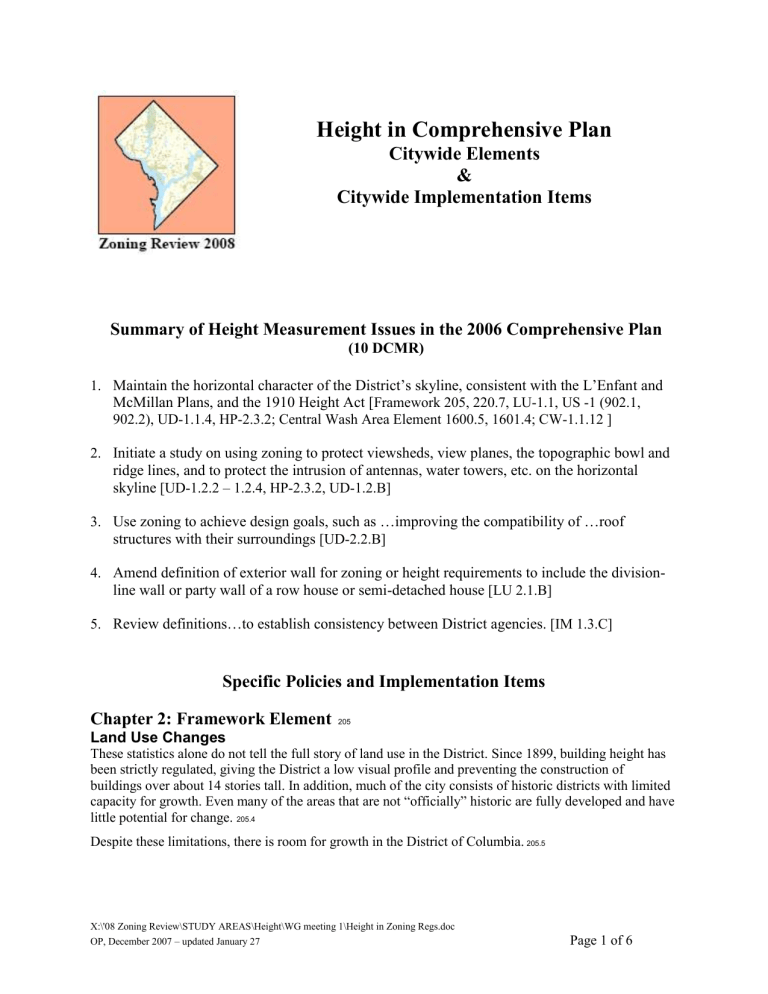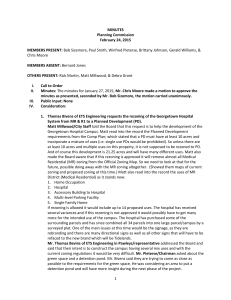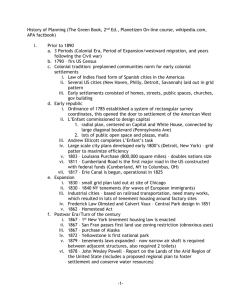Height in Comprehensive Plan

Height in Comprehensive Plan
Citywide Elements
&
Citywide Implementation Items
1.
Summary of Height Measurement Issues in the 2006 Comprehensive Plan
(10 DCMR)
Maintain the horizontal character of the District’s skyline, consistent with the L’Enfant and
McMillan Plans, and the 1910 Height Act [ Framework 205, 220.7, LU-1.1, US -1 (902.1,
902.2), UD-1.1.4, HP-2.3.2; Central Wash Area Element 1600.5, 1601.4; CW-1.1.12 ]
2.
Initiate a study on using zoning to protect viewsheds, view planes, the topographic bowl and ridge lines, and to protect the intrusion of antennas, water towers, etc. on the horizontal skyline [UD-1.2.2 – 1.2.4, HP-2.3.2, UD-1.2.B]
3.
Use zoning to achieve design goals, such as …improving the compatibility of …roof structures with their surroundings [UD-2.2.B]
4.
Amend definition of exterior wall for zoning or height requirements to include the divisionline wall or party wall of a row house or semi-detached house [LU 2.1.B]
5.
Review definitions…to establish consistency between District agencies.
[IM 1.3.C]
Specific Policies and Implementation Items
Chapter 2: Framework Element
205
Land Use Changes
These statistics alone do not tell the full story of land use in the District. Since 1899, building height has been strictly regulated, giving the District a low visual profile and preventing the construction of buildings over about 14 stories tall. In addition, much of the city consists of historic districts with limited capacity for growth. Even many of the areas that are not “officially” historic are fully developed and have little potential for change.
205.4
Despite these limitations, there is room for growth in the District of Columbia.
205.5
X:\'08 Zoning Review\STUDY AREAS\Height\WG meeting 1\Height in Zoning Regs.doc
OP, December 2007 – updated January 27
Page 1 of 6
Connecting the City: Guiding Principles
31. The District’s communities are connected by a shared heritage of urban design, reflecting the legacy of the L’Enfant Plan, the McMillan Plan, the Height Act of 1910, and preservation of much of the historic urban fabric. After more than two centuries of building, the nation’s capital is still a remarkable place.
Urban design and streetscape policies must retain the historic, majestic, and beautiful qualities that make
Washington unique among American cities (220.7)
Building Green and Healthy Communities: Guiding Principles
32. The site selected for the national capital was characterized by a very special topography, including hills interlaced with broad rivers and streams. The topography allowed for the construction of a special collection of buildings that give the District a unique profile. This profile has been further protected by local and national ordinances and must continue to be protected in the future. This should include the protection of views and vistas and the enhancement of city gateways (221.1)
Definitions of Land Use Categories
225 relates typical heights and or stories for residential and commercial categories to the Comp
Plan land use categorization.
Chapter 3 Land Use Element
LU-1.1 Strengthening the Core
304
Between 2005 and 2025, approximately 30 percent of the District of Columbia’s future housing growth and 70 percent of its job growth will occur within the urban core of the city and adjacent close-in areas along the Anacostia River. This growth must be accommodated in a way that protects the area’s historic texture, including the street and open space frameworks established by the L’Enfant and McMillan Plans, the 1910 height limit, and the vistas and monumental spaces that define the central city. Infill and redevelopment will take place within the established business districts west of 5 th
Street NW, but a majority of the central city’s future growth will be achieved through redevelopment of areas on its east side.
304.2
Policy LU-1.3.5: Edge Conditions Around Transit Stations
Ensure that development adjacent to Metrorail stations is planned and designed to respect the character, scale, and integrity of adjacent neighborhoods. For stations that are located within or close to low density areas, building heights should “step down” as needed to avoid dramatic contrasts in height and scale between the station area and nearby residential streets and yards.
306.14
Policy LU-2.3.3: Buffering Requirements
Ensure that new commercial development adjacent to lower density residential areas provides effective physical buffers to avoid adverse effects. Buffers may include larger setbacks, landscaping, fencing, screening, height step downs, and other architectural and site planning measures that avoid potential conflicts.
311.5
Policy LU-2.4.4: Heights and Densities in Regional Centers
Maintain heights and densities in established and proposed regional centers which are appropriate to the scale and function of development in adjoining communities and which step down to adjacent residential areas, and maintain or develop buffer areas for neighborhoods exposed to increased commercial densities.
312.
Chapter 6 Environmental Protection Element
Action E-3.2.A: Building Code Revisions
Evaluate regulatory obstacles to green building construction in the District, and work to reduce or eliminate such obstacles if they exist. Adopt amendments to the International Construction Code as
X:\'08 Zoning Review\STUDY AREAS\Height\WG meeting 1\Height in Zoning Regs.doc
OP, December 2007 – updated January 27
Page 2 of 6
necessary to promote green building methods and materials, and to encourage such actions as stormwater harvesting, graywater reuse, waterless urinals, and composting toilets.
614.4 [ green roofs, solar and hot water harvesting]
Chapter 7 Economic Development Element
ED-2.1 The Office Economy
707
Central Washington includes a number of sub-markets, each providing different amenities and locational advantages. The largest of these submarkets are Downtown, traditionally defined as the area east of 16 th
Street and south of Massachusetts Avenue; and the Golden Triangle, extending from 16 th
Street west to
Foggy Bottom and north to Dupont Circle. Smaller office districts exist in Georgetown, on Capitol Hill, along the avenues of Upper Northwest Washington, around L’Enfant Plaza, and in the Southeast Federal
Center and North Capitol Street areas. The large geographic expanse of the city’s office market has been driven at least partially by height limits and the sizeable area dedicated to federal uses and open space in the heart of the city.
707.2
Action ED-2.2.B: Retail Ceiling Heights
Determine the feasibility of zoning amendments which would permit higher ground floor retail ceiling heights in commercial and mixed use districts. The building height limits in several zone districts preclude the development of ground floor space in keeping with national standards without reducing overall gross leasable building area or placing a portion of the ground floor below the street level.
708.13
Chapter 9 Urban Design Element
UD-1 Toward A Stronger Civic Identity
902
Washington’s identity is defined by a particular set of physical features, including the Potomac and
Anacostia Rivers, the topographic “bowl” of the original city and the rolling hills that surround it, the open spaces and dense tree canopy of its parks and neighborhoods, and the wide diagonal boulevards and rectangular street grid. The city is further defined by its horizontal skyline. The Virginia and Maryland suburbs contain the region’s tallest buildings while the central city is characterized by lower buildings of relatively uniform mass and height.
902.1
The Height Act has given the District its unique horizontal character.
The character of the central city has largely been shaped by the L’Enfant and McMillan Plans and the
1910 Height of Buildings Act . The L’Enfant Plan in particular set the stage for conditions that define almost every new development in the historic center of the city today. The radial arrangement of streets and public spaces has created many irregular and prominent building sites. The Height Act has resulted in a predominance of structures that are as wide as they are tall, and a street environment that has more in common with Paris than it does with New York, Chicago, and other cities in North America.
902.2
UD-1.1 Protecting the Integrity of Washington’s Historic Plans
903
Policy UD-1.1.4: Height Act of 1910
Protect the civic and historical character of the city, particularly the “horizontal” urban quality of Central
Washington, by limiting building heights in accordance with the Height Act of 1910. Basic principles of the Height Act are shown in Figure 9.4.
903.10
X:\'08 Zoning Review\STUDY AREAS\Height\WG meeting 1\Height in Zoning Regs.doc
OP, December 2007 – updated January 27
Page 3 of 6
Policy UD-1.2.2: Protecting the Topographic “Bowl”
Consistent with the Federal Elements of the Comprehensive Plan, maintain the prominence of the topographic bowl formed by lowland and rim features of the L’Enfant city (see text box). This should include preserving the green setting of the Anacostia hills and maintaining the visual prominence of the
Florida Avenue escarpment.
904.4
Policy UD-1.2.3: Ridgeline Protection
Protect prominent ridgelines so as to maintain and enhance the District’s physical image and horizontal skyline.
904.5
Policy UD-1.2.4: View Protection
Recognize and protect major views in the city, particularly characteristic views of city landmarks, and views from important vantage points. Recognize the importance of views to the quality of life in the city and the identity of Washington and its neighborhoods.
904.6
Action UD-1.2.B: Creating View Plane Regulations
Conduct a review of desirable views, creating view plane diagrams, affording analysis of desired possibilities, and developing zoning regulations accordingly.
904.10
UD-2.1 Place-Making in Central Washington
909
Design decisions for Central Washington should also address the peculiar architectural dynamics created by the 1910 Height Act. Currently, the desire to maximize buildable floor area while adhering to height limits often results in buildings with very little sculptural form. The most innovative and distinctive buildings tend to be public places—museums, libraries, and other structures where maximizing rentable space is not the primary objective. This is consistent with the city’s architectural heritage in some respects, but there are still opportunities to improve the design of office, residential, and retail buildings in the central city.
909.4
While the height limit clearly affects building form, it also affects street life in unexpected ways. It results in ground floors that are sunken below grade by as much as several feet to maximize the number of stories that can be accommodated in each building. This in turn creates challenges for street-level
X:\'08 Zoning Review\STUDY AREAS\Height\WG meeting 1\Height in Zoning Regs.doc
OP, December 2007 – updated January 27
Page 4 of 6
retailers, and impacts the experience of walking or shopping downtown. Other challenges include the appearance of vents, mechanical equipment, and other essential rooftop elements that exceed the maximum building height. The design of these elements takes on special importance given their high visibility on an otherwise “flat” downtown skyline.
909.5
Action UD-2.1.A: Retail Ceiling Heights Convene a Task Force of retailers, developers, architects, and others to evaluate alternative approaches to achieving higher first-floor ceiling heights in new
Downtown buildings.
909.15
Action UD-2.2.A: Scale Transition Study
Complete a “Scale Transition Study” which evaluates options for improving design compatibility between more dense and less dense areas. The study should respond to the varying situations where higher density development is (or will be) situated adjacent to lower density, predominantly residential neighborhoods. It should include design guidelines and provisions for buffers (including open space), stepping down of building heights, and solutions that reflect the different lot dimensions, block faces, and street and alley widths found in different parts of the city.
910.25
Action UD-2.2.B: Using Zoning to Achieve Design Goals
Explore zoning and other regulatory techniques to promote excellence in the design of new buildings and public spaces. Zoning should include incentives or requirements for facade features, window placement, courtyards, buffering, and other exterior architectural elements that improve the compatibility of structures, including roof structures, with their surroundings while promoting high architectural quality.
910.26
Chapter 10 Historic Preservation Element
Policy HP-2.3.2: Historic Image of the City
Protect and enhance the views and vistas, both natural and designed, which are an integral part of
Washington’s historic image. Preserve the historic skyline formed by the region’s natural features and topography and its historically significant buildings and monuments from intrusions such as communication antennas and water towers. Preserve the horizontal character of the national capital through enforcement of the 1910 Height of Buildings Act.
1010.4
*****************************************************************
Volume 3 Implementation Element Chapter 25
LU-2.1.B: Amendment of Exterior Wall Definition .
Amend the city’s procedures for roof structure review so that the division-on-line wall or party wall of a row house or semi-detached house is treated as an exterior wall for the purposes of applying zoning regulations and height requirements. [OP, OZ, DCRA Short-Term N]
RESIDENT IAL LAN D USE COMPAT IBILITY
LU-2.3.A: Zoning Changes to Reduce Land Use Conflicts in Residential Zones . As part of the comprehensive rewrite of the zoning regulations, develop text amendments which: expand buffering, screening, and landscaping requirements along the edges between residential and commercial and/or industrial zones; more effectively manage the non-residential uses that are permitted as a matter of- right within commercial and residential zones in order to protect neighborhoods from new uses which generate external impacts; ensure that the height, density, and bulk requirements for commercial districts balance business needs with the need to protect the scale and character of adjacent residential neighborhoods; provide for ground-level retail while retaining the residential zoning along major corridors; ensure that there will not be a proliferation of transient accommodations in any one neighborhood. OP, OZ, DCRA, ZC Mid-term N
LU-2.4.C: Mixed Use District with Housing Emphasis. Develop a new mixed use zoning district, to be applied principally on land that is currently zoned for non-residential uses (or that is now unzoned), which limits
X:\'08 Zoning Review\STUDY AREAS\Height\WG meeting 1\Height in Zoning Regs.doc
OP, December 2007 – updated January 27
Page 5 of 6
commercial development to the ground floor of future uses and requires residential use on any upper stories.
[OZ, OP, ZC Short-Term N]
H-1.5.B: Changes to the Zoning Regulations. Explore changes which would facilitate development of accessory apartments, English basements and single room occupancy housing units. [OZ, OP, DCRA, ZC
Short-Term N]
E-3.2.A: Building Code Revisions . Evaluate regulatory obstacles to green building construction in the District, and work to reduce or eliminate such obstacles if they exist. Adopt amendments to the International
Construction Code as necessary to promote green building methods and materials, and to encourage such actions as stormwater harvesting, gray water reuse, waterless urinals, and composting toilets. [DCRA, DOE
Mid-Term N]
UD-1.2.A: Review of Zoning Designations. Conduct a review of zoning designations in environmentally sensitive areas, including wetlands, riparian areas and upland areas along stream valleys, steep slopes, and areas of soil instability to identify areas where current zoning may permit excessive density, given site constraints. [DOE, OP, OZ Mid-Term N]
UD-2.1.A: Retail Ceiling Heights. Convene a Task Force of retailers, developers, architects, and others to evaluate alternative approaches to achieving higher first-floor ceiling heights in new Downtown buildings.
[DMPE D, DBID, OP Mid-Term N]
UD-2.2.A: Scale Transition Study.
Complete a “Scale Transition Study” which evaluates options for improving design compatibility between more dense and less dense areas. [OP Short-Term N]
UD-2.3.B: Form-Based Zoning Codes. Explore the use of form-based zoning codes on selected large sites as a way of establishing desired urban design characteristics without rigidly prescribing allowable uses. [OP, OZ
Short-Term N]
IM-1.3.C: Review of Definitions. Review the definitions used in planning, zoning, building, and housing codes to determine if changes are needed to establish consistency between District agencies. [OP, OZ, OA G Short-
Term N]
SLC December 19, 2007; revised January 27
X:\'08 Zoning Review\STUDY AREAS\Height\WG meeting 1\Height in Zoning Regs.doc
OP, December 2007 – updated January 27
Page 6 of 6







